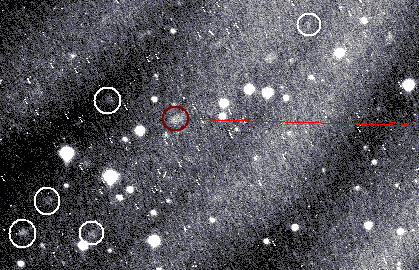

 |
 |
SENTINEL |
12/10/02 12:21:31 PM Pacific Standard Time
Kent:
Here is an updated photo from Dec. 4th, 2002 of PX and it's moons from
http://www.zetatalk.com/teams/tteam342.htm

PX is circled in burgundy and it's moons in white. Note that PX's apparent direction of travel towards the right (red arrow) is only an illusion created by Earth's travel in the opposite direction as it orbits counter-clockwise between PX and the Sun. In reality, PX is not moving to the right, but coming directly toward us. As this photo was taken only 2 days after Earth intersected the perpendicular of PX's inbound path, PX appears offset only ever so slightly to the right of it's actual position in the sky. Figuratively speaking, this photo was taken looking straight down the barrel of the gun. PX will "appear" to continue to travel to the right (and increasingly downward) until March 2nd when Earth reaches the point in it's orbit where it is 90 degrees (1AU) to the left of PX's path. As we continue in our counter-clockwise orbit, circling us back behind the sun and closer to realigning with PX's path, it's "apparent" direction of travel will again reverse and seemingly move back towards the left, below where it appears now. However, it will have already passed us by the time we realign with it's path on the opposite side of the sun on June 2, 2003 as it disappears above and to the right of the constellation Sagittarius, which is the general direction it will return from in 8 years on it's return journey, back towards it's Nemesis.
Whizadree requested in a previous post that the following orbital elements be provided for PX.
Here they are, at least as accurately as can be determined at the present time. It should also be remembered that these figures describe an orbit around a binary star system, which is why 2 figures are given for perihelion and aphelion and closest and furthest distance from our sun. The binary orbit will also cause the true eccentricity to much greater than that calculated.
perihelion = approx. 141.84 (AU)
distance of closest approach to the Sun = approx. 0.4 - 0.5 (AU)
aphelion = approx. 374.3 (AU)
furthest distance from the Sun = approx. 890.44 (AU)
D = asteroid diameter = approx. 51,024 (km)
a = semimajor axis = approx. 516.14 (AU)
e = orbital eccentricity = approx. 0.725
i = orbital inclination wrt J2000.0 ecliptic = approx. 11 (deg) extra-solar; approx. 32 (deg) intra-solar
argperi = argument of perihelion wrt J2000.0 ecliptic = approx. 0 - 10 (deg)
node = longitude of ascending node wrt J2000.0 ecliptic approx. 74.74 (deg)
M = mean anomaly approx. arc = approx. 1.5 (deg)
class = taxonomic class = C
arc = observation arc = approx. 370 (days)
Nobs = number of observations approx. = 10 (publically known)
EU = approximate plane-of-sky ephemeris uncertainty (arcseconds), which is calculated from arc, Nobs, and the number of observed apparitions, designated CEU in the Lowell Observatory database. (See the Lowell Observatory page for more information.) See: zetatalk´s coordinates page.
Date: 12/11/02 1:55:25 PM Pacific Standard Time
Kent, your page pxmoons.htm contains some confusion:
A perihelion of 141.84 AU and a closest approach to the Sun of 0.4-0.5 AU, that's outright contradictory. Please look at that more closely, one of them must be wrong. Peri-helion is Greek for 'upon the Sun' or closest to the Sun. And there's two entirely different values for that.
SENTINEL
In the purest application of the terms:
perihelion = approx. .04(AU)
aphelion = 890.44(AU)
But these terms assume our sun (Helios) is the sole gravitational focus of the orbit or eclipse. If you base your calculations on this false assumption, then yes, it does not add up.
However, as I understand it, PX´s orbit has two (physical) foci, Helios and it´s dead twin "Nemesis" for lack of a proper name. They are approx. 878.6(AU) apart. Nemesis is at an 11 degree incline to the sun´s ecliptic. At it´s closest approach to the sun PX comes within .04 - .05(AU) of the sun. However, given it´s mass and escape velocity of approx. .08(AU/hour) it continues in a relatively straight vector, instead of curving tightly around the sun near it´s point of perihelion. At a distance of approx. 141.84(AU)the sun´s continual attraction/drag on PX´s escape velocity cancels it sufficiently for it to arc and fall back towards the sun, (the effective perihelion). It then again comes within about .5 (AU)of the sun on it´s outward trajectory toward it´s aphelion. It continues to what should normally be it´s (effective) aphelion at approx. 374.3 (AU). However, instead of cycling back, the combination of it´s momentum and "Nemesis´" gravitation attraction is enough to recapture it after lingering at this Legrange point for a lengthy period. The cycle then repeats itself, except with Nemesis serving as the primary focus. It can only be assumed that the perinemeson and apnemeson would be very similar to the perihelion and aphelion.
Note: In recent news, an expended Saturn rocket booster unexpectedly showed up in Earth orbit after being in orbit around the sun for several decades. By late fall it was expected to transfer back into a helioscentric orbit again after lingering at the Legrange point between the Earth and Sun for some time. I believe the formula used to calculate this rocket-booster´s bifocal orbit would be similar to that which would be used to determine PX´s bifocal orbit.
